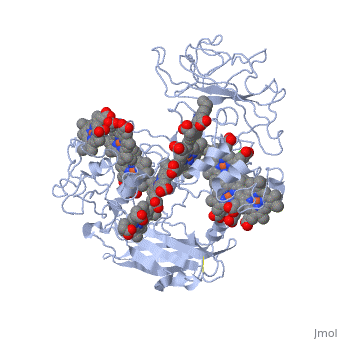Sandbox Reserved 386
From Proteopedia
| This Sandbox is Reserved from September 14, 2021, through May 31, 2022, for use in the class Introduction to Biochemistry taught by User:John Means at the University of Rio Grande, Rio Grande, OH, USA. This reservation includes 5 reserved sandboxes (Sandbox Reserved 1590 through Sandbox Reserved 1594). |
To get started:
More help: Help:Editing. For an example of a student Proteopedia page, please see Photosystem II, Tetanospasmin, or Guanine riboswitch. |
|
Contents |
MtrF
General Information
MtrF is a cell surface cytochrome on the Gram-negative bacteria known as Shewanella oneidensis..[1] MtrF is involved with shuttling electrons across its (S. oneidensis) outer surface. MtrF has several homologues, MtrC and the protein OmcA. These three different proteins are thought to be replaceable with one another in deletion mutation experiments.[1]
Regulation of MtrF
A prime example of MtrF regulation is the study of "Regulation of MtrF Expression in Neisseria gonorrhoeae and Its Role in High-Level Antimicrobial Resistance".[2] In this study the expression of MtrF was repressed by MtrR (the major repressor in the mtrCDE expression). Another repressor known as MpeR can also regulate the expression of MtrF. Repression of MtrF by MtrR and MpeR was used, demonstrating that the repressive effects mediated by these regulators are independent processes. MtrF was also disabled and the significant reduction in the induction of hydrophobic agent resistance and it was found that the expression of MtrF is enhanced when Gonococci are grown under inducing conditions.
References
- ↑ 1.0 1.1 Fotinou C, Emsley P, Black I, Ando H, Ishida H, Kiso M, Sinha KA, Fairweather NF, Isaacs NW. The crystal structure of tetanus toxin Hc fragment complexed with a synthetic GT1b analogue suggests cross-linking between ganglioside receptors and the toxin. J Biol Chem. 2001 Aug 24;276(34):32274-81. Epub 2001 Jun 19. PMID:11418600 doi:10.1074/jbc.M103285200
- ↑ Folster JP, Shafer WM. Regulation of mtrF expression in Neisseria gonorrhoeae and its role in high-level antimicrobial resistance. J Bacteriol. 2005 Jun;187(11):3713-20. PMID:15901695 doi:10.1128/JB.187.11.3713-3720.2005

